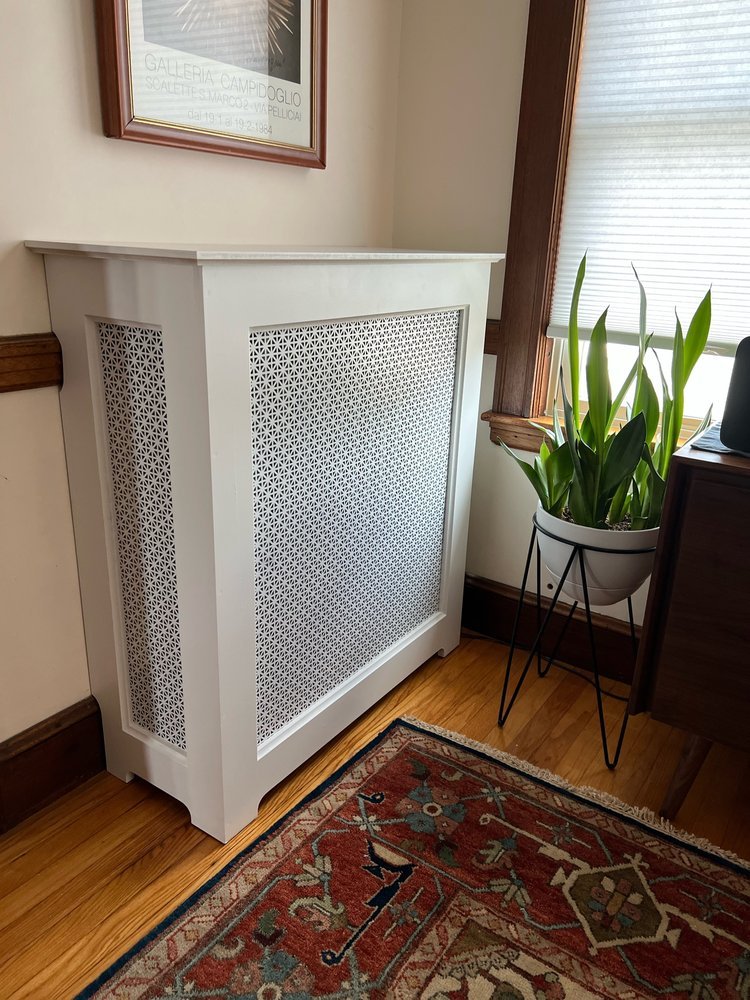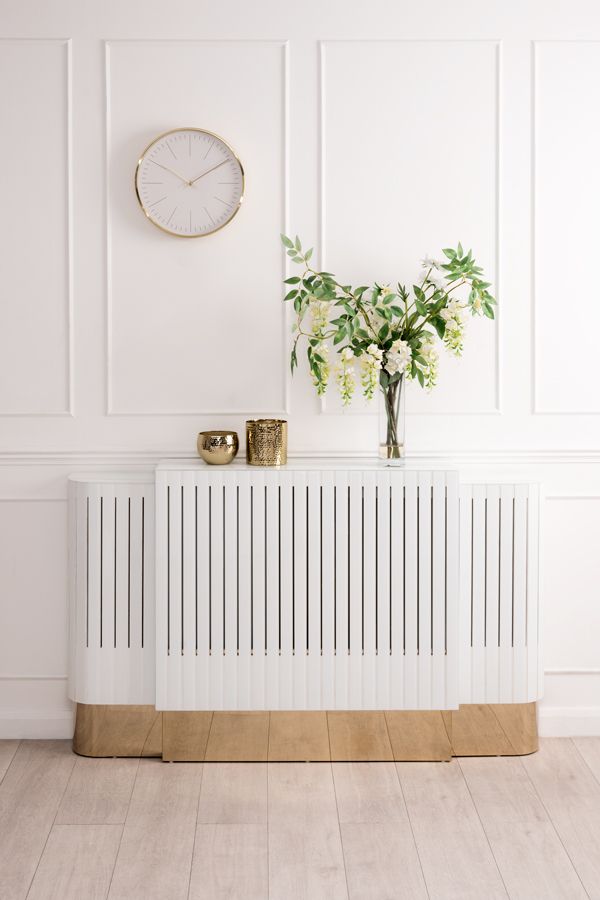Installing wood radiator covers: A DIY Guide for Beginners
Installing wood radiator covers: A DIY Guide for Beginners
Blog Article
The Relevance of a Radiator Cover for Enhancing Home Aesthetics and Safety And Security
Radiator covers serve a dual objective in the home, providing both visual improvement and safety advantages. They can transform a useful burner into an elegant style function, while also supplying a barrier versus unintentional burns. Picking the best cover can greatly affect an area's atmosphere. The choice of material and layout can be challenging. Understanding these facets is vital for any kind of property owner aiming to balance design and safety efficiently.
The Useful Benefits of Radiator Covers
Radiator covers offer numerous useful benefits that improve both the performance of heating unit and the general aesthetics of a space. Mostly, these covers aid to direct heat a lot more equally throughout a room, avoiding warm places and guaranteeing a comfy environment. By encasing the radiator, they safeguard it from dirt and particles, which can prevent its efficiency. Additionally, radiator covers can lower heat loss by minimizing the amount of warm air that gets away right into empty areas.Safety is another essential aspect; covers can stop unintended burns, especially in homes with children or animals. Additionally, they develop an obstacle that prevents products from being positioned straight on the radiator, which can pose fire risks. In general, radiator covers not only enhance heating performance yet additionally add to a safer home, making them an important consideration for any type of home.
Enhancing Home Looks Snappy
Radiator covers offer a distinct possibility to boost a home's visual appeal through numerous style choices. With a broad variety of materials, styles, and shades offered, house owners can quickly coordinate these aspects to complement their indoor decoration. This adaptability permits both functionality and visual enhancement in any kind of living room.
Design Versatility Options
While numerous homeowners concentrate on capability when selecting home heating options, the aesthetic allure of radiator covers ought to not be overlooked - wood radiator covers. Radiator covers deal a large range of design convenience, enabling them to flawlessly blend with numerous interior designs. From sleek, contemporary designs that complement contemporary rooms to ornate, vintage-inspired covers that enhance typical decoration, there is a cover to match every taste. Furthermore, personalized choices make it possible for home owners to pick shades, patterns, and surfaces that harmonize with their existing furnishings and wall surface treatments. This versatility not just boosts the overall visual of an area but likewise permits for creative expression, transforming an often ignored component right into a trendy focal factor. Inevitably, the best radiator cover can boost a room while maintaining comfort
Material Choices and Styles
Picking the appropriate materials for radiator covers considerably influences both visual appeals and performance within a home. Typical products consist of wood, metal, and MDF, each offering distinct styles and benefits. Wooden covers emanate heat and charm, making them suitable for standard or rustic interiors. Steel options, commonly sleek and modern-day, supply a contemporary touch while ensuring durability. MDF, a functional and economical selection, can be conveniently repainted or ended up to match any kind of style. The layout style should straighten with the total theme of the home, whether minimal, industrial, or standard. Eventually, picking the ideal material not just boosts the aesthetic charm of the space but also guarantees safety and security and reliable heat distribution, striking a balance in between type and feature.
Color Coordination Techniques
Shade sychronisation plays a crucial duty in improving home appearances, specifically when integrating radiator covers right into the total style scheme. Picking a color that complements existing style can produce a harmonious setting. A neutral cover can mix perfectly with wall surfaces, while a strong shade can offer as a striking focal factor. Patterns or structures can also be used to add deepness and interest, making certain the radiator cover contributes favorably to the room's setting. Additionally, coordinating the cover's color with furnishings or accents can combine the room. Property owners should take into consideration the overall color palette and illumination, as these components influence just how shades communicate, inevitably improving both design and safety within the home.
Security First: Shielding Your Family members
Guaranteeing a secure home environment is critical, specifically when children or family pets are existing. Radiators, while vital for home heating, can pose significant dangers. Their steel surfaces come to be very hot during procedure, developing a risk of burns if touched. A radiator cover acts as an effective barrier, safeguarding at risk family members from unintentional call with these warmed surfaces.In enhancement to stop burns, radiator covers help to eliminate sharp edges and protruding components that might result in injuries. By confining the radiator, they also reduce the probability of products falling onto the burner, which can produce fire threats. A properly designed cover can discourage kids from utilizing the radiator as a play surface area, thereby lessening the threats of falls or other accidents. Ultimately, purchasing a radiator cover not just improves the visual allure of a home yet substantially adds to the security and well-being of its citizens.
Picking the Right Material for Your Radiator Cover
When it involves choosing a radiator cover, the product plays a considerable duty in both functionality and aesthetics. Typical selections include timber, metal, and MDF, each offering unique benefits (metal radiator covers). Wooden covers supply a warm, traditional look and can be easily customized with stains or paints. Nonetheless, they may not be suitable for moist environments, as wetness can warp the product over time. Metal covers, commonly made from steel or aluminum, deal toughness and a modern-day visual however may require extra insulation to stop heat loss. Meanwhile, that site MDF is affordable and versatile, enabling for different finishes, though it might not endure heats along with various other materials. Ultimately, the choice of product need to line up with the property owner's style preferences, the meant area of the radiator cover, and any kind of particular useful demands, guaranteeing a perfect balance between kind and function

Layout Ideas to Complement Your Decor
While a radiator cover offers a useful purpose, it can likewise improve a space's overall aesthetic. Different layout concepts can transform a fundamental cover right into an eye-catching prime focus. For modern insides, sleek metal or minimal wooden layouts can supply a sophisticated touch. In comparison, rustic homes could take advantage of recovered timber covers, which include warmth and character.Painted radiator covers can seamlessly blend with wall surface shades, developing a cohesive appearance, while patterned materials can introduce appearance and visual interest.In areas with a classic ambiance, elaborate styles or decorative grilles can stimulate a feeling of fond memories. In addition, incorporating racks in addition to the cover can use practical area for plants or decorative items, even more boosting the decor.Ultimately, the option of layout should reflect the property owner's individual style, making certain that the radiator cover matches the total theme of the area.
Setup Tips for a Smooth Fit
Proper setup of a radiator cover begins with precise measurements to assure a snug fit. Picking the ideal material is just as essential, as it affects both performance and visual charm. Adhering to these guidelines can greatly boost the general appearance and performance of the radiator cover.
Measure Your Radiator Precisely
Exact dimensions are important for accomplishing a smooth fit when setting up a radiator cover. One should gauge the size, elevation, and depth of the radiator, ensuring to record the most sticking out parts. It is a good idea to use a measuring tape for precision, keeping in mind dimensions in both inches and centimeters for adaptability. Additionally, gauging the range from the floor to the top of the radiator assists in identifying just how high the cover needs to rest. Taking right into account any pipelines or valves that might prolong from the radiator can protect against future issues. It is smart to verify dimensions to prevent errors, as also small inconsistencies can lead to ill-fitting covers that compromise both appearances and performance.
Choose the Right Product
Selecting the suitable product for a radiator cover is crucial for both functionality and aesthetics. Different materials, such as timber, metal, and MDF, offer distinct benefits. Wood offers a warm, classic look but may call for routine maintenance to avoid bending. Steel is sturdy and can endure high temperatures, yet may not mix effortlessly with all interior designs. MDF, while affordable and functional, might not be as heat-resistant as various other alternatives. It is necessary to think about the designated link environment; for instance, a restroom might take advantage of moisture-resistant products. Furthermore, matching the cover with existing style enhances the total layout. Ultimately, the picked material needs to balance style, sturdiness, and safety to assure a smooth fit and lasting charm in any type of home.
Upkeep and Care for Radiator Covers
While radiator covers can enhance the visual charm of a room, their upkeep and care are important for making sure optimal capability. Routine cleansing is crucial to stop dust build-up, which can obstruct warmth flow. Utilizing a soft towel or duster will certainly suffice; extreme chemicals must be avoided to protect the finish of the cover.Inspecting the cover regularly for any type of indicators of damage, such as rust or warping, is additionally vital. Immediate repair work can lengthen the life expectancy of the cover and maintain its look. For wood covers, occasional polishing might be necessary to keep the surface intact and avoid drying out or cracking.Additionally, making sure that the cover is effectively fitted and firmly affixed to the wall can avoid accidents, especially in homes with children or animals. By focusing on maintenance, house owners can take directory pleasure in both the aesthetic and useful benefits of their radiator covers for years to come.
Regularly Asked Questions

Can Radiator Covers Improve Energy Performance in My Home?
Radiator covers can potentially improve energy performance by directing warmth into the space instead of shedding it directly to wall surfaces. This may result in a much more consistent temperature and decreased energy usage in time.
Are There Certain Radiator Cover Styles for Vintage Homes?
Radiator covers for classic homes commonly feature ornate layouts, such as intricate carvings or classic patterns - buy radiator covers online. Designs like Art Deco or Victorian can enhance the home's architecture while offering practical advantages. Personalized choices are likewise offered
How Do I Determine My Radiator for a Cover?
To determine a radiator for a cover, one ought to note the height, width, and depth. In addition, determining any kind of outcroppings or components guarantees a correct fit, making it possible for the selection of an appropriate and practical radiator cover.
Can I Customize a Radiator Cover to Fit My Decoration?
Yes, tailoring a radiator cover to fit certain decor is feasible. Alternatives include picking materials, colors, and designs that enhance existing home furnishings, permitting a smooth assimilation right into the overall aesthetic of the space.
What Are one of the most Common Products Utilized for Radiator Covers?

Report this page